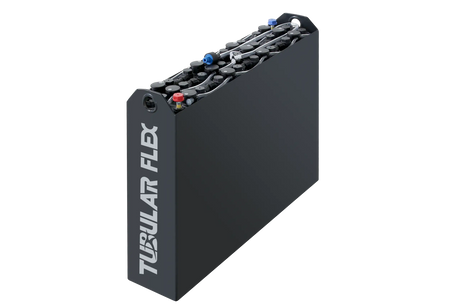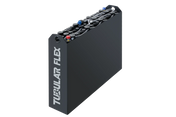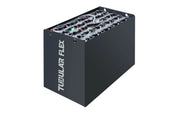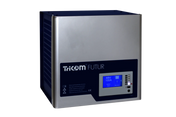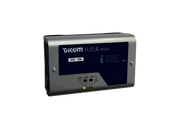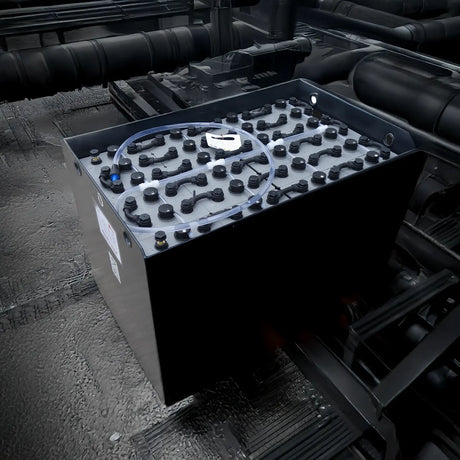General questions
How does a forklift battery work?
How does a forklift battery work?
A forklift battery, typically a lead-acid battery, relies on a chemical reaction between lead plates (electrodes) and sulfuric acid (electrolyte). During charging, the lead sulfate deposits on the plates are converted into lead dioxide (at the positive electrode) and pure lead (at the negative electrode). This stores energy. During discharging, this process is reversed, releasing electricity that powers the forklift.
What is in a forklift battery?
What is in a forklift battery?
A forklift battery, typically a lead-acid battery, contains lead plates as electrodes and dilute sulfuric acid as the electrolyte. The lead plates are alternately positively and negatively charged and divided into cells, while the sulfuric acid serves as the medium through which the electrons move during the charging and discharging process.
How many volts does a forklift battery have?
How many volts does a forklift battery have?
The voltage of a forklift battery varies depending on the model and requirements. Typical voltages for forklift batteries range from 12 V to 80 V, with 24 V, 36 V, 48 V, and 80 V being the most common. The exact voltage depends on the specific application and performance requirements.
How long does a forklift battery last?
How long does a forklift battery last?
The service life of a forklift battery depends on the type and usage. Typically, it can be specified as approximately five years or 1,500 to 2,000 charging cycles with proper maintenance and handling.
Is a forklift battery hazardous material?
Is a forklift battery hazardous material?
A forklift battery, especially a lead-acid battery, is classified as dangerous goods. This is due to the hazardous substances it contains, such as sulfuric acid and lead. Therefore, the relevant safety and hazardous goods regulations must be observed during transport.
What does battery sulfation mean?
What does battery sulfation mean?
Battery sulfation is a natural process in which lead sulfate crystals form on the plates of a lead-acid battery when it is discharged. These crystals can impair battery performance and reduce its capacity over time. To minimize sulfation, you should charge and maintain the battery regularly. Professional regeneration can help restore already sulfated batteries.
How much does a forklift battery weigh?
How much does a forklift battery weigh?
The weight of a forklift battery varies depending on its size and type. Small batteries for light forklifts typically weigh between 100 kg and 300 kg, while larger batteries for heavy forklifts can weigh between 800 kg and over 2,000 kg. Lead-acid batteries are particularly heavy due to the heavy lead plates and electrolyte.
What types of forklift batteries are there?
What types of forklift batteries are there?
Forklift batteries are primarily lead-acid batteries, which can be divided into three main categories: traditional lead-acid batteries (PbS), plate batteries (PzS), and plate batteries in gel form (PzB). These batteries are convincing due to their cost-effectiveness and widespread availability, but require regular maintenance, such as refilling with water. Gel batteries (PbGel) and AGM batteries (PbAGM) are variants of lead-acid technology that are characterized by lower maintenance requirements and leak-proofness. AGM batteries also impress with their vibration resistance. Lithium-ion batteries impress with their high energy density and freedom from maintenance, but are associated with higher costs. Nickel-cadmium batteries (NiCd) score points for their robustness and suitability for extreme temperatures, but are increasingly criticized due to environmental concerns.
When is a forklift battery defective?
When is a forklift battery defective?
A forklift battery is considered defective or faulty if it no longer charges or discharges properly, significantly loses capacity, emits unusual noises or odors, exhibits visible damage such as cracks or leaks, or if individual cells are significantly weaker than others. These symptoms indicate that the battery is no longer working efficiently and may need to be replaced.
How many kilowatt hours does a forklift battery have?
How many kilowatt hours does a forklift battery have?
The kilowatt-hours (kWh) of a forklift battery vary depending on the size and type. Typically, they range from 5 kWh to 40 kWh. For example, a 48-volt battery with a capacity of 500 ampere-hours (Ah) can store approximately 24 kWh of energy (48 volts x 500 Ah = 24,000 watt-hours or 24 kWh). The exact capacity depends on the battery voltage and the number of ampere-hours.
Care
How do you maintain a forklift battery?
How do you maintain a forklift battery?
Maintaining a forklift battery includes regularly topping up with distilled water to maintain the correct electrolyte level, but only after charging. It's important to avoid deep discharge and to charge the battery regularly and fully. The battery and terminals should be kept clean and free of corrosion. A regular visual inspection for damage and leaks should also be performed. Learn more here.
What happens if there is too little water in a forklift battery?
What happens if there is too little water in a forklift battery?
If there is too little water in a forklift battery, the lead plates can become exposed and corrode, reducing the battery's performance and capacity. The battery can also overheat because the water is needed for cooling and chemical reactions. This can cause irreversible damage to the battery cells and significantly shorten the battery's lifespan.
Can you "repair" a forklift battery?
Can you "repair" a forklift battery?
Yes, forklift battery repair, often referred to as "cell swapping" or "battery regeneration," is possible. This involves replacing defective cells or components. However, this work should be performed by a professional to ensure battery safety and performance.
What water is used for forklift batteries?
What water is used for forklift batteries?
Distilled water is used for forklift batteries, especially lead-acid batteries. This water is free of minerals and contaminants that could damage the battery cells. It is used to maintain the electrolyte level in the cells and ensure optimal battery function.
How often does a forklift battery need to be replaced?
How often does a forklift battery need to be replaced?
The need for a forklift battery replacement depends on its usage and maintenance. Forklift batteries should typically be replaced every five years or after approximately 1,500 to 2,000 charge cycles. Careful maintenance and proper handling can extend the battery's lifespan, while constant overloading or neglect of maintenance may lead to earlier replacement.
Can you use tap water to fill a forklift battery?
Can you use tap water to fill a forklift battery?
Tap water should not be used to fill a forklift battery, as it contains minerals and contaminants that can be harmful to the battery. These substances can cause chemical reactions within the battery, resulting in reduced performance and a shortened service life. Instead, always use distilled or demineralized water, as it is free of these contaminants.
Why do you need to vent a forklift battery when charging it?
Why do you need to vent a forklift battery when charging it?
When charging a forklift battery, especially a lead-acid battery, adequate ventilation must be ensured, as gases may be released during the charging process. These gases, primarily hydrogen and oxygen, are produced during the electrolysis of the water in the electrolyte. Inadequate ventilation can lead to a buildup of these gases, which poses a risk of explosion and can be harmful to health. Therefore, it is important that the charging process takes place in a well-ventilated area to ensure a safe environment.
Load
How do you charge a forklift battery?
How do you charge a forklift battery?
A forklift battery is charged by connecting it to a suitable charger. First, turn off the forklift and ensure the battery connections are clean and secure. Then, connect the charger to the battery, ensuring the charger voltage matches the battery voltage. Connect the charger to a power source and begin charging. Once charging is complete, disconnect the charger first from the power source and then from the battery. It is important to fully charge the battery regularly to maximize its lifespan.
How deeply can a forklift battery be discharged?
How deeply can a forklift battery be discharged?
Ideally, a forklift battery should not be discharged below 20 to 30% of its total capacity. Deeper discharge, also known as deep discharge, can damage the battery cells and significantly shorten the battery's lifespan. It's important to regularly charge the battery before it becomes too deeply discharged to maximize its performance and lifespan.
When should you charge a forklift battery?
When should you charge a forklift battery?
Ideally, a forklift battery should be charged when it has reached approximately 20 to 30% of its capacity. To extend the battery's lifespan, deep discharges should be avoided.
How long does it take to charge a forklift battery?
How long does it take to charge a forklift battery?
The charging time of a forklift battery depends on its capacity and the charger used. Typically, a fully discharged forklift battery can be recharged after a charging time of 8 to 12 hours.
How do I check if a forklift battery is empty?
How do I check if a forklift battery is empty?
To check if a forklift battery is discharged, you can use a multimeter to measure the battery's total voltage. A voltage significantly below the battery's nominal voltage indicates that the battery is discharged. Another method is to check the individual cell voltages. If these are significantly below 2 volts per cell, the battery is likely discharged. A sudden drop in the forklift's power can also indicate a discharged battery.
Top up forklift battery water: before or after charging?
Top up forklift battery water: before or after charging?
It is recommended to add distilled water to the forklift battery before charging. This ensures that the electrolyte sufficiently covers the battery cells during charging to ensure even charging. Adding water after charging may result in uneven distribution and impair performance.

